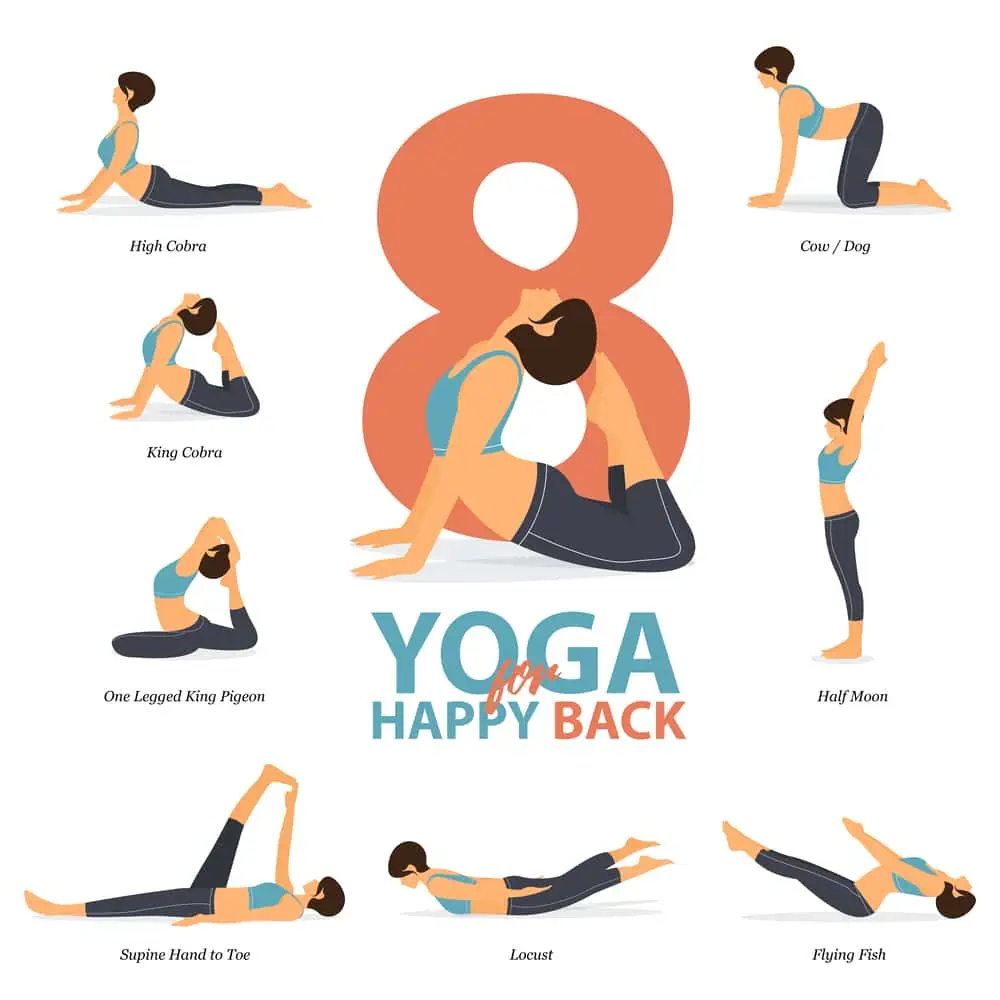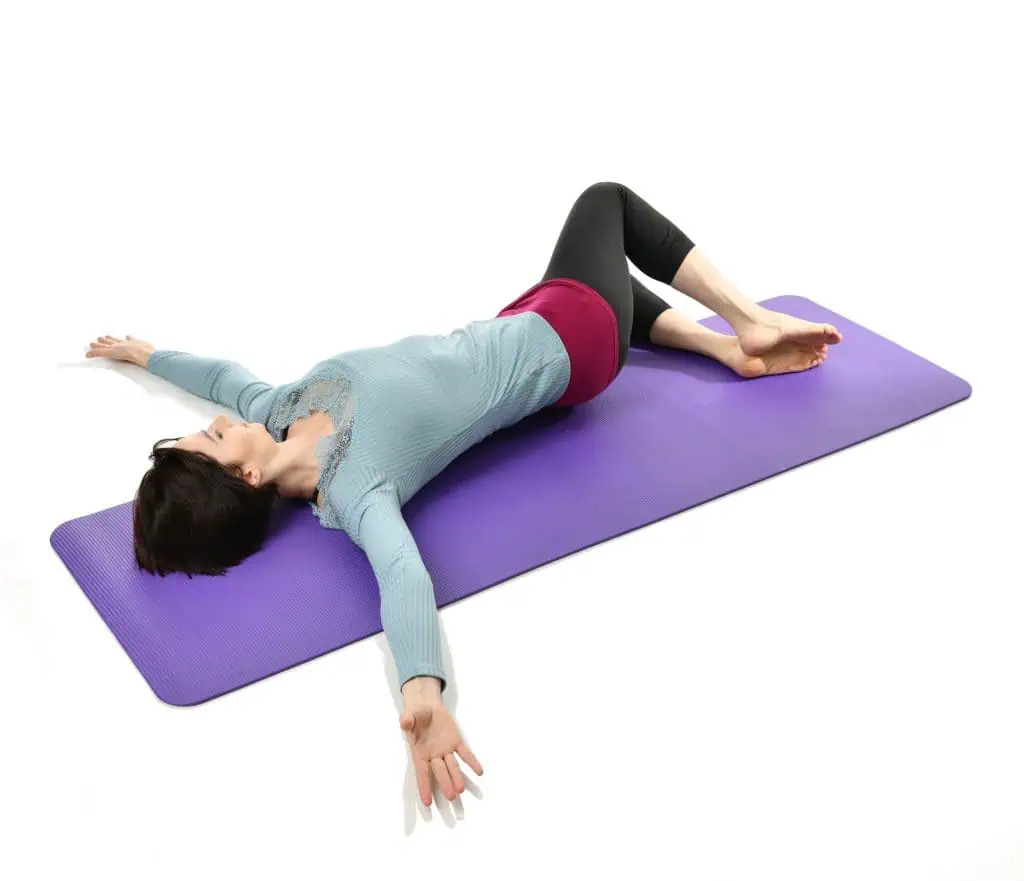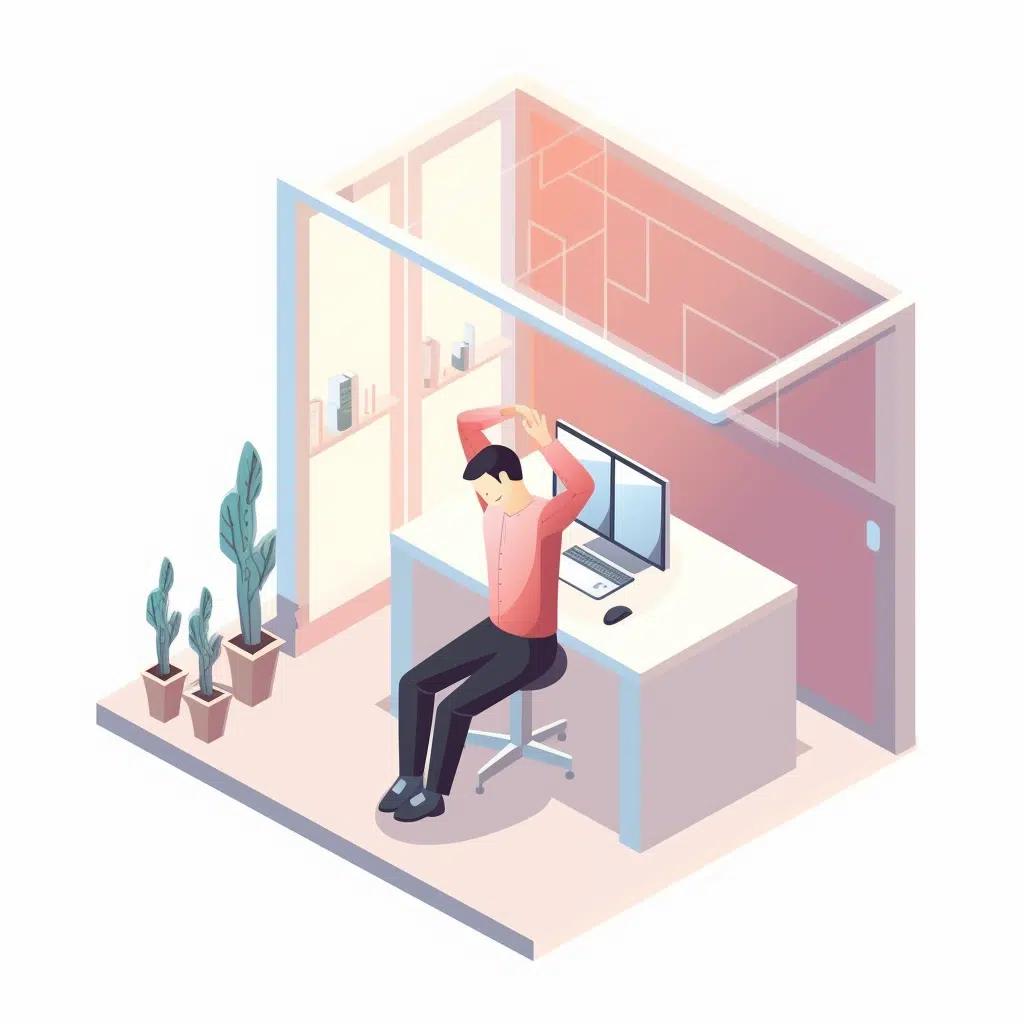Are you suffering from sciatica pain and seeking a natural, effective way to find relief? Look no further, as yoga for sciatica pain relief might just be the answer you’ve been searching for. The practice of yoga offers a range of poses that target the muscles surrounding the sciatic nerve, helping to alleviate pain and prevent future flare-ups. In this blog post, we will explore 9 essential yoga poses designed to provide relief from sciatica pain, improve posture, and promote relaxation through yoga for sciatica.
But first, let’s delve deeper into understanding sciatica, its causes, and symptoms. By doing so, we can better comprehend how yoga for sciatica can help with pain relief and why it’s important to practice safely and effectively.

Key Takeaways
- Understanding Sciatica involves being aware of its causes and symptoms, such as pain, weakness, and tingling.
- Yoga is a beneficial form of exercise for sciatica sufferers as it helps to strengthen and stretch the muscles surrounding the sciatic nerve.
- Consulting a healthcare professional can help create an effective yoga practice tailored to individual needs that contributes to relief from sciatica pain.
Understanding Sciatica: Causes and Symptoms
Sciatica is a painful condition that arises from the irritation or compression of the body called sciatic nerve, often due to a herniated disc or spinal stenosis. The primary symptoms of sciatic nerve pain include pain, weakness, and a tingling sensation in the affected areas. With sciatica nerve pain occurring, it is estimated that up to 40% of individuals may experience sciatica at some point in their lifetime.
A determination of the root cause of your sciatica sciatic nerve pain is key to developing the most effective treatment plan. Common causes of sciatic pain include herniated discs and spinal stenosis. In some cases, sciatica can be caused by piriformis syndrome, which is when the piriformis muscle irritates the sciatic nerve.
Fortunately, yoga poses provide a natural, gentle method for easing sciatica pain and offering the sciatica pain relief you need, complementing physical therapy.
The Benefits of Yoga for Sciatica pain relief
Yoga has been shown to be beneficial for relieving sciatica pain, as it can help to stretch and strengthen the muscles surrounding the sciatic nerve, improve posture, and promote relaxation. In fact, numerous studies support the use of yoga therapy for lower back conditions. Practicing yoga allows you to enhance spinal flexibility, fortify back and glute muscles, and boost overall mobility, contributing significantly to pain relief.
Maintaining the correct posture is vital for spinal health, and yoga can effectively improve your body’s alignment, thereby offering significant relief from sciatica pain. By incorporating yoga into your regular routine, you can not only alleviate current discomfort but also prevent future occurrences of sciatica.
Precautions and Tips for Practicing Yoga with Sciatica
Before you start a yoga routine for sciatica relief, you should consult a healthcare professional to verify that yoga practice is safe and appropriate for your particular condition. Once you’ve received the green light from your doctor, it’s crucial to listen to your body and avoid any poses that may exacerbate pain or cause further injury.
It’s advisable to adopt a gentle and progressive approach when practicing yoga for sciatica, particularly when working on the piriformis muscle. Overworking the piriformis may result in spasms and deep buttock pain, which may or may not be accompanied by sciatic pain. By being mindful and cautious during your practice, you can help ensure a safe and effective yoga experience that brings relief from sciatica pain.
9 Effective Yoga Poses for Sciatica Relief
This section will introduce 9 effective yoga poses that can aid in relieving sciatica pain. These poses include:
- Reclined Spinal Twist
- Extended Triangle Pose
- Half Lord of the Fishes Pose
- Pigeon Pose
- Cat-Cow Stretch
- Downward Facing Dog
- Child’s Pose
- Bridge Pose
- Legs-Up-the-Wall Pose
Each of these poses targets specific muscles surrounding the sciatic nerve, providing relief and promoting relaxation.
Reclined Spinal Twist
The Reclined Spinal Twist is a gentle pose that stretches the lower back and hips, including the lumbar spine, helping to relieve sciatic pain. To perform this pose, follow these steps:
- Begin by lying on your back with your arms extended out to the sides.
- Bring your right knee up to your chest, while the left leg remains extended.
- Exhale and drop the right knee over to the left side of your body, twisting the spine and low back. Gaze towards the right fingertips.
- Remain in this pose for 10-25 breaths.
- On an inhalation, slowly come back to center, bringing both knees to your chest.
- Release and repeat on the other side.
It’s important to exercise caution when practicing this pose to prevent exacerbating your sciatica symptoms. Here are some tips to keep in mind:
- Refrain from going too far into the pose if it increases your symptoms.
- Activate your core muscles to support your back during the twist.
- Approach the pose cautiously and do not strain yourself into the position.
- If you experience any sharp or jabbing pain, discontinue the pose immediately.

Extended Triangle Pose
The Extended Triangle Pose is an excellent pose for sciatica relief, as it stretches the hamstrings, hips, and spine, promoting flexibility and reducing sciatic pain. To perform this pose, take the following steps:
- Begin in Tadasana (Mountain Pose).
- Step or lightly jump your feet 3 1/2 to 4 feet apart.
- Raise your arms parallel to the floor.
- Open your torso to the left, keeping the left and right sides of the torso equally long.
- Allow the left hip to come slightly forward and lengthen the tailbone toward the floor.
- Engage the right thigh muscles and draw the right femur into its socket.
- Extend the right hand toward the front of the room, keeping the right hip tucked.
Like any yoga pose, it’s important to maintain proper form and technique while practicing the Extended Triangle Pose. In addition, be mindful of the impact of your posture on sciatica pain, as proper posture can provide considerable relief from pain.
Half Lord of the Fishes Pose
The Half Lord of the Fishes Pose provides a deep stretch for the hips, glutes, and lower back, targeting the piriformis muscle and relieving sciatic pain. To perform this pose, follow these steps:
- Begin by sitting on the floor with your legs extended in front of you.
- Bend your right knee and place your right foot on the outside of your left thigh.
- Inhale and extend your spine.
- Exhale and twist your torso to the left, bringing your left elbow to the outside of your right knee.
- Place your right hand on the floor behind you for support.
- Gradually deepen the twist with each exhale, while maintaining an extended spine.
- Hold the pose for several breaths.
- Release and repeat on the other side.
Exercise caution and follow safety measures while practicing the Half Lord of the Fishes Pose, especially if you are suffering from severe sciatica. Be sure to avoid overstretching or straining when performing this pose, as doing so could exacerbate your symptoms.
Pigeon Pose
The Pigeon Pose is a deep hip opener that stretches the piriformis muscle and helps alleviate sciatic pain. To perform this pose, follow these steps:
- Begin in a hands and knees position.
- Bring your left knee forward.
- Extend it out to the left side.
- Slide your right leg back and tuck your toes under.
- Make sure your hips are squared and your hands are beneath your shoulders.
- Inhale and lift your chest forward and up, extending your spine.
- Exhale and hinge forward, increasing the stretch in your outer hip and glutes.
- Maintain an upright torso and a relaxed breath while in the pose.
- Repeat on the other side by bringing your right knee forward and following the same steps.
Just like other yoga poses, it’s important to exercise caution while practicing the Pigeon Pose to relieve sciatica. Be mindful of your body’s limitations and avoid overstretching or straining, which could worsen your symptoms.
Cat-Cow Stretch
The Cat-Cow Stretch improves spinal flexibility and strengthens the back muscles, helping to relieve sciatica pain. To perform this pose, follow these steps:
- Start in a tabletop position on your hands and knees, with your hands shoulder-width apart and your fingers spread wide.
- Inhale, arch your back, and lift your chest and tailbone toward the sky.
- Exhale, round your spine, and draw your chin toward your chest.
- Repeat this sequence for several breaths, focusing on slow and controlled movements.
While practicing the Cat-Cow Stretch, be mindful of common mistakes to avoid, like hunching the shoulders, straining the neck, and overdoing the spinal motion. By doing so, you can ensure a safe and effective practice that brings relief for your sciatica pain.
Downward Facing Dog
Downward Facing Dog is an excellent pose for sciatica relief, as it stretches the entire back body, including the hamstrings and lower back, helping to alleviate pain. To perform this pose, follow these steps:
- Begin in a tabletop position on your hands and knees, with your hands shoulder-width apart and your fingers spread wide.
- Curl your toes and raise your hips up and back, pressing your chest towards your thighs.
- Keep your legs straight and your heels pressing towards the floor.
- Maintain a long neck and gaze towards your navel.
For optimal benefits, it is recommended to hold the Downward Facing Dog position for approximately 5-6 breaths. By practicing this pose regularly, you can help reduce sciatica pain and improve overall flexibility.
Child’s Pose
Child’s Pose is a gentle stretch for the lower back and hips, providing relief from sciatica pain. To perform this pose, follow these steps:
- Begin by kneeling on the floor with your toes together and your knees hip-width apart.
- Sit back on your heels and fold forward, allowing your forehead to rest on the floor and your arms to extend alongside your body or rest on your belly.
- Hold the pose for several breaths, focusing on deep breathing and relaxation.
When practicing Child’s Pose, be sure to move slowly and carefully to avoid putting excessive pressure on the sciatic nerve and exacerbating symptoms. By incorporating this gentle stretch into your yoga practice, you can help alleviate sciatica pain and promote relaxation.

Bridge Pose
Bridge Pose strengthens the back and glute muscles while stretching the hip flexors, helping to alleviate sciatic pain. To perform this pose, follow these steps:
- Begin by lying on your back with your knees bent and feet hip-distance apart. Place your arms alongside your body.
- Press your feet into the floor and inhale as you lift your hips up, rolling your spine off the floor.
- Gently squeeze your knees together to maintain a hip-width distance.
- Hold the pose for a few breaths before slowly lowering your hips back down to the floor.
By practicing Bridge Pose regularly, you can help to strengthen the muscles that support your spine and improve flexibility in the hips and lower back, which are essential for alleviating sciatica pain.
Legs-Up-the-Wall Pose
Legs-Up-the-Wall Pose is a gentle inversion that helps to relieve lower back pain and sciatica by promoting relaxation and improving circulation. To perform this pose, follow these steps:
- Sit with your right side against a wall.
- Bend your knees and draw your feet in toward your hips, keeping your left leg straight.
- Swing your legs up along the wall, keeping your heels and sitting bones touching the wall.
- Relax your arms by your sides or place them on your belly.
- Stay in this position for 5-15 minutes, focusing on deep breathing and relaxation.
By practicing Legs-Up-the-Wall Pose regularly, you can help to alleviate sciatica pain and promote relaxation. Be sure to move slowly and carefully during this pose to avoid putting excessive pressure on the sciatic nerve.
How to Incorporate Yoga into Your Sciatica Treatment Plan
Adding yoga to your sciatica treatment plan can contribute to pain relief and prevent future flare-ups. For optimal results, it’s advisable to consult a healthcare professional before starting any yoga practice, as they can ascertain if yoga is safe and suitable for your particular condition. It’s also crucial to listen to your body and avoid any poses that may exacerbate pain or cause further injury.
Consider working with a qualified yoga instructor to develop a personalized practice tailored to your needs. A knowledgeable instructor can help you learn proper form, technique, and modifications for poses that target the areas of your body affected by sciatica, ensuring a safe and effective practice. By practicing yoga consistently, ideally two to three times a week, you can better manage your sciatica symptoms and work towards long-term relief.
Summary
Throughout this blog post, we’ve explored the causes and symptoms of sciatica and the benefits of yoga for alleviating pain. We’ve introduced 9 essential yoga poses for sciatica relief, each targeting specific muscles surrounding the sciatic nerve and promoting relaxation. We’ve also discussed essential precautions and tips for practicing yoga with sciatica and how to incorporate yoga into your treatment plan.
We hope that this information has provided you with valuable insights and tools to help you find relief from sciatica pain. By incorporating yoga into your treatment plan and practicing with care, you can work towards a more comfortable and pain-free life.
Frequently Asked Questions
Is it OK to do yoga with sciatica?
Yoga is an ideal choice for those with sciatica, as it does not involve any high-impact or brisk movements that may do more harm than good. Many people in the US use yoga for sciatica pain relief safely.
What yoga positions help sciatica?
Yoga poses such as Cobra (Bhujangasana), Child’s Pose (Balasana), Cat-Cow Stretch (Marjaryasana-Bitilasana) and Downward Facing Dog (Adho Mukha Svanasana) are all effective for relieving sciatica pain. Other recommended poses include Half Moon Pose, Locust Pose, Knees-to-Chest Pose, Reclined Pigeon Pose and Bridge Pose.
What is the number one exercise for sciatica?
Riding a stationary bike and walking are the best exercises to help relieve sciatica pain. Low-impact activities help reduce pressure on your lower back, allowing for greater ease of movement with fewer risks.
Can yoga really help alleviate sciatica pain?
Yes, yoga has been proven to be effective in relieving sciatica pain by stretching and strengthening the muscles around the nerve, improving posture, and promoting relaxation.
How often should I practice yoga for sciatica relief?
Practicing yoga two to three times a week is recommended for effective for sciatica pain relief.












